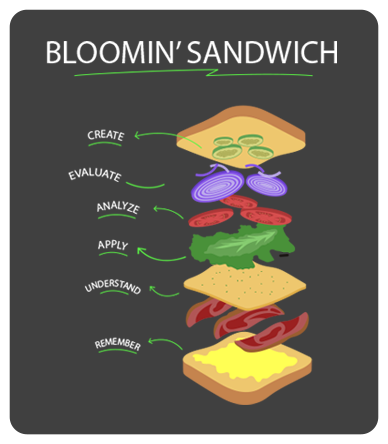Before creating your next eLearning course, ask yourself this question: What do you want your learners to do after completing your course?
Ideally, your course will equip your learners with new knowledge and skills so that they will be able to perform new tasks, or perform old tasks with better accuracy or improved results. All too often we fixate on what learners need to understand, and we lose sight of what we actually need them to be able to do after completing the course. While understanding is a necessary part of the educational process, it’s not enough. We can’t stop there, or else what good is that knowledge?
Writing Learning Outcomes: The Basics
In both academic and corporate settings, the most commonly used model for writing learning objectives is This framework outlines six categories of educational goals: Knowledge, Comprehension, Application, Analysis, Synthesis, and Evaluation. Often depicted as a pyramid with Knowledge at the bottom, the taxonomy asserts that basic knowledge and comprehension are the building blocks for the critical thinking and higher-level skills that follow.

When writing learning objectives, practitioners often look to Bloom’s Taxonomy for sample verbs (or “action words”) to use in their statements. For example, learning objectives referring to the Application stage may include “solve,” “demonstrate,” or “interpret,” and objectives referring to the highest level, Evaluation, may include “judge” and “critique.”
Learning objectives serve several purposes in courses (no matter whether you’re designing eLearning courses or traditional in-person classes). First, objectives outline the goals for the course. They’re guidelines for course creators to follow to ensure content is tightly aligned to the intended objectives and doesn’t meander off-topic. Second, objectives are helpful indicators for students when selecting which course(s) to take. Objectives succinctly promise outcomes by communicating what the student can expect to accomplish. Third, objectives determine how the students should be assessed upon completion of the instruction. When the objectives clearly state, “Upon completion of this course, you will be able to…”, the assessment should determine whether or not students can perform that task.
Examples of Measurable Learning Objectives
All of these factors speak to the necessity of writing measurable learning objectives, but how will you know if your students are successful?
Consider the following examples of learning objectives from a culinary arts program. Which do you find to be more measurable?
- The learner will understand the steps of making a sandwich.
- The learner will arrange the illustrated steps of making a sandwich into a numbered sequence.
Of course, these students need to understand how to make a sandwich. But how will you know they truly understand? You have to see them do it, or hear them explain it, or (using the example above) arrange illustrations in order depicting how they would make a sandwich.
In short, understanding isn’t good enough. Without action, you have no way of knowing whether or not learners understand.
Let’s return to Bloom’s Taxonomy. Would you consider arranging the illustrated steps of making a sandwich to be a high-level or low-level skill? Where on the pyramid would this activity fall?
It’s possible someone could simply memorize the order of the steps without using any critical thought. Simple recall is the lowest step on Bloom’s Taxonomy because while it can show understanding, there’s little to no nuance or higher-level thinking skills required.
Let’s move up a step. Once the learner can list the steps in order, how could they show application? Could they actually build a sandwich using real materials?
What about analysis? Could they make reasonable substitutes if someone they’re feeding has allergies or specific food preferences?
What about evaluation? Can they determine whether or not a sandwich is a healthy lunch option when compared to other meals?
Consider how comparing the health outcomes of choosing sandwiches over other meals is an entirely different, and entirely more sophisticated, skill set than organizing the steps of sandwich production in the correct order. Whether you’re training fast food employees to follow recipes when creating customers’ orders or training personal chefs to create customized menus based on their clients’ dietary needs, the overall process of using learning objectives is the same. Write and follow clear, concise, measurable learning objectives to ensure your learners’ needs are met. These measurable objectives will guide you in not only presenting your content but in assessing your students’ ability to use this information in meaningful ways.
Designing eLearning Courses with the End in Mind
Now reflect on the courses you create for your learners; are you asking them to simply recall basic facts, or are you giving them the opportunity to demonstrate higher-level thinking skills? Are your learning objectives, course content, and assessments in line with the performance you expect of them upon completing the training?
In summary, no matter who your audience is, the topic you’re covering, or the format of your instruction, a good learning objective is written with three distinguishing characteristics:
Educational models such as Bloom’s Taxonomy provide a reference for novice and experienced instructional designers alike by encouraging practitioners to consider how learners can best demonstrate their knowledge. Measurable learning objectives directly correlate to the observable actions learners will take during both training and on the job, and allow you to assess students’ full range of capabilities.






